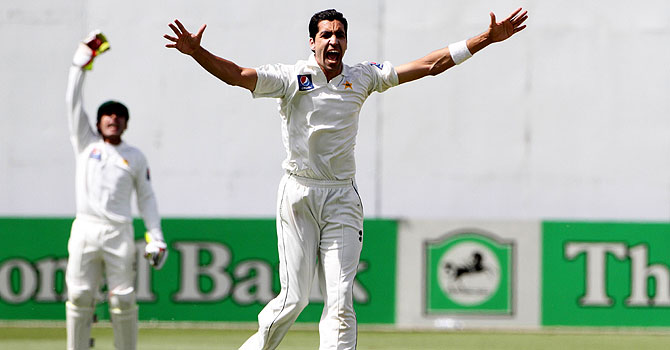Umar Gul has remained the linchpin of Pakistan’s bowling attack ever since the spot-fixing scandal derailed the careers of Mohammad Asif and the prodigious Mohammad Amir.
Gul has had a topsy-turvy run in ODIs, performed like a dream in T20s but his Test returns are still ordinary compared to the leading fast bowlers of the present time.
Former fast bowlers have been of the opinion that Gul has been best when a clear role has been defined for him. As Pakistan prepare for the three-match Test series against the world’s best outfit in their own den, it is clear that Gul will have to spearhead the fast bowling pack. The enormous task of leading newcomers Junaid Khan, Mohammad Irfan and possibly Ehsan Adil against South Africa’s classy order, falls squarely on his shoulders.
Pakistani fast bowlers have played pivotal roles in the ODI wins that the team has notched up against the Proteas at home, and even their two Test wins out of nine matches have come on the back of incisive spells from the quicks.
Waqar Younis and Shoaib Akhtar combined with the wizardry of Mushtaq Ahmed in Durban in 1998 while Akhtar, who bowled only in one innings, partnered with Asif to deliver the knockout punch at Port Elizabeth in 2007.
Fresh prospects
Despite their performances in the limited-overs formats in India the trio of Gul, Irfan and Junaid together are untested in Test cricket.
While Gul and Junaid have played in the longest format together in Sri Lanka, the lanky Irfan is yet to make his debut and there remains a question mark on his sustainability for the rigours of the five-day game.
Considering this, Gul’s role becomes magnified. If Pakistan are to dismantle the host’s battling line, brimming with acts like Hashim Amla, Graeme Smith, Jacques Kallis and AB de Villiers, the ‘Guldozer’ will have to roll.
This is the Peshawar-born fast bowler’s first Test series in South Africa; so far he has claimed a mere 10 wickets in the four Tests he has featured in against them in Pakistan and UAE.
Overall too, his record at Test level borders on the ordinary, a return of 158 wickets at 33.68 runs per wicket is hardly going to send shivers down the spine of any class batting line-up. The 28-year-old has managed only four five-wicket hauls in his 45-match Test career.
Gul made his Test debut in 2003 against Bangladesh but it was the Lahore Test in 2004 versus India that truly put the bowler in the spotlight. His five wickets in the first innings put a dent in the Indian line up but his solitary wicket in the second made a mess of VVS Laxman’s stumps and captured the imagination of the Pakistan fans.
Since then, Gul has put in the odd brilliant performance against top sides, but the scarcity of fast bowling resources at the Test level has meant that he has been a steady influence. After the loss of Amir and Asif he has played a useful role backing up the quality spinners Pakistan has relied on recently.
Since August 2010, Gul has featured in 15 Tests and taken 50 wickets without a single five-wicket haul; the matches have been spread across UAE, New Zealand, West Indies, Sri Lanka and Bangladesh.
In South Africa, the conditions will suit him. The ball flies off a length at the first two venues Wanderers, Johannesburg, and New Lands, Cape Town. There is some seam movement on offer as well, but especially Johannesburg, especially, can see runs come quickly due to the nature of the wicket and a lightning fast outfield.
Here Gul’s experience would come in handy, provided he keeps his head. He would have to aim for a consistent line and length with due reliance on his ‘heavy ball’, the venomous bouncer he has up his sleeve. He should not forget also that he has a potent yorker in his repertoire that can surprise and barge through the defences of the best in the business.
The biggest question, though, is whether the ‘senior’ player is ready for the challenge? At times, he looks clueless with the red cherry and seems to run out of options fast when the batsmen are dominating.
In his last two Tests played in Sri Lanka last summer he claimed a solitary wicket conceding 220 runs. Even on a lively Pallekele wicket, venue for the last Test, the right-armer failed to make inroads.
Gul, perhaps, is the embodiment of Pakistan cricket. He can be two different bowlers within the space of a dozen deliveries. The challenge for him on this tour is to rise and be counted as Pakistan weathers the storm against a well-oiled machine.
If he has to go down in the annals of the game as one of Pakistan’s best he would have to deliver against the best, keep it consistent and account for over a dozen scalps if Pakistan are to win the series.
Captain Misbah-ul-Haq has already laid it down to his boys: ‘perform a notch beyond your ability if you are to surmount the South Africans’.
Gul has to do exactly the same and if he does, he would for sure become the world-class act he has threatened to since long.












































